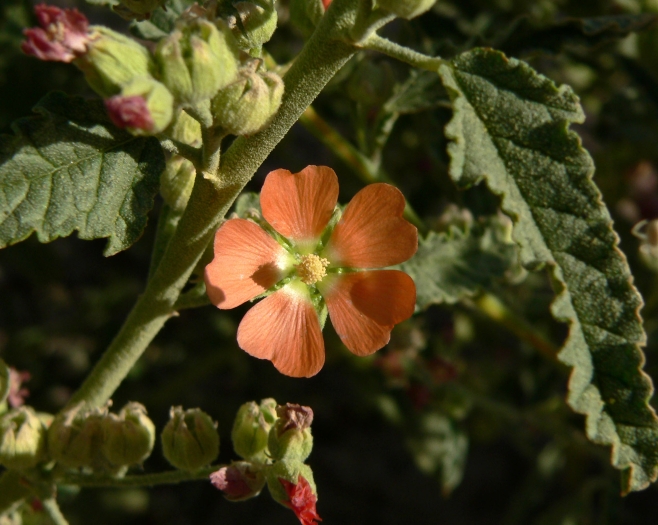Copper Globemallow
(Sphaeralcea angustifolia)
Copper Globemallow (Sphaeralcea angustifolia)
/
/

Stan Shebs
CC BY-SA 3.0
Image By:
Stan Shebs
Recorded By:
Copyright:
CC BY-SA 3.0
Copyright Notice:
Photo by: Stan Shebs | License Type: CC BY-SA 3.0 | License URL: https://creativecommons.org/licenses/by-sa/3.0 | Uploader: Stan Shebs | Publisher: Wikimedia Commons | Title: Sphaeralcea_angustifolia_3.jpg | Notes: {{Information |Description={{en|1=Cyathea brownii - Royal Botanic Gardens, Sydney}} |Source={{own}} |Author=[[User:Poyt448|Poyt448]] Peter Woodard |Date=2010-09-01 |Permission=ok |other_versions=no }} [[Category:Cyathea]] [[Category:Flora of Norfolk Isla |

















































Estimated Native Range
Summary
Sphaeralcea angustifolia, commonly known as Copper Globemallow, is an evergreen perennial subshrub or herb native to open grasslands, desert areas, and scrublands in the Southwestern United States and Mexico. It can reach up to three meters in height and is characterized by its woolly or felt-like texture. The gray-green, lance-shaped leaves measure up to about 5 cm long with wavy or slightly lobed edges. The plant produces a leafy inflorescence with several flowers, each showcasing five wedge-shaped orange petals just under 1 cm in length and yellow anthers, blooming from late spring to early fall. The flowers are moderately showy and attract pollinators.
Copper Globemallow is valued for its drought tolerance and ability to thrive in challenging environments, making it suitable for xeriscaping and naturalistic plantings. It is also used for erosion control due to its robust root system. In cultivation, it requires full sun exposure and well-drained soils, tolerating a range of soil types from sandy to loamy. While it is low-maintenance and requires minimal water once established, it is important to avoid overwatering. Gardeners should be aware that Sphaeralcea angustifolia can become invasive outside its native range, so it is crucial to consult local guidelines before planting.CC BY-SA 4.0
Copper Globemallow is valued for its drought tolerance and ability to thrive in challenging environments, making it suitable for xeriscaping and naturalistic plantings. It is also used for erosion control due to its robust root system. In cultivation, it requires full sun exposure and well-drained soils, tolerating a range of soil types from sandy to loamy. While it is low-maintenance and requires minimal water once established, it is important to avoid overwatering. Gardeners should be aware that Sphaeralcea angustifolia can become invasive outside its native range, so it is crucial to consult local guidelines before planting.CC BY-SA 4.0
Plant Description
- Plant Type: Subshrub, Herb
- Height: 1-4 feet
- Width: 1-2 feet
- Growth Rate: Moderate
- Flower Color: Orange, Yellow
- Flowering Season: Fall, Spring, Summer
- Leaf Retention: Evergreen
Growth Requirements
- Sun: Full Sun
- Water: Low
- Drainage: Fast
Common Uses
Bee Garden, Bird Garden, Drought Tolerant, Hummingbird Garden, Low Maintenance, Potted Plant, Street Planting
Natural Habitat
native to open grasslands, desert areas, and scrublands in the Southwestern United States and Mexico
Other Names
Common Names: Copper Globe-Mallow, Narrow-Leaved Globemallow, Hierba Del Negro, Vara De San José, Bandmalva
Scientific Names: , Sphaeralcea angustifolia, Sphaeralcea angustifolia subsp. angustifolia, Sphaeralcea angustifolia var. cuspidata, Sphaeralcea lobata, Malva angustifolia, Sphaeralcea emoryi var. nevadensis, Sphaeralcea emoryi subsp. nevadensis, Sphaeralcea angustifolia var. lobata, Sphaeralcea cuspidata
GBIF Accepted Name: Sphaeralcea angustifolia (Cav.) G.Don